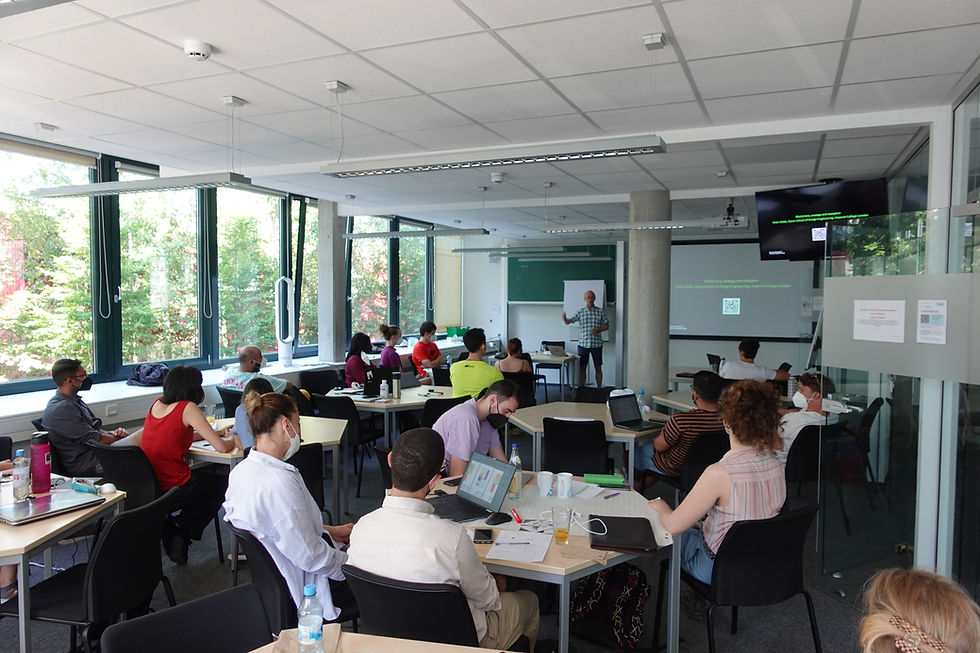Cradle to Cradle: The interdisciplinary skills of circularity
- CIRCuIT
- Nov 8, 2022
- 3 min read
Updated: Nov 10, 2022
By Livia Nastasi

The second CIRCuIT summer school took place at Hamburg's University of Technology in July 2022. Here, school attendee and PhD student Livia Nastasi shares reflections and learnings from the school to apply in practice.
As a PhD student at the Politecnico di Torino, Italy, my research project aims to develop a methodology to support, measure and evaluate the transition towards a circular economy for companies that operate in the industrial sector. Specifically, I’m working on the circularity assessment of a company operating in the industrial vehicle, agricultural and construction equipment sector. Attending the CIRCuIT summer school at Hamburg’s University of Technology was an opportunity to experience and learn about circular economy within the construction sector and complement my learning thus far.
Circular economy as an ‘umbrella concept’
Although it may be considered niche, the circular economy can be defined as an “umbrella concept” since it is far reaching and can be applied across multiple contexts. It represents a shift towards more sustainable practices, spanning not just environmental but social and economic dimensions too. Indeed, the application of circular economy principles lowers GHG emissions, reduces energy consumption and the use of virgin material, while supporting efficient production and consumption models by the adoption of sharing, reusing, recycling, repairing, refurbishing, remanufacturing - and it creates new jobs opportunities. Thus, I believed the CIRCuIT summer school would be an occasion to focus on how the circular economy can be implemented specifically in the construction sector and to meet other students, both PhD and Master, from different countries who study topics around circular economy and sustainability.
Blending skills with concepts
Throughout the interactive week, we went on four different site visits, each followed by engaging lessons and workshops led by the CIRCuIT team. We organized ourselves into five multidisciplinary teams and were assigned real, scenario-based tasks to apply our knowledge with practical learnings and skills to present back to the rest of the group.
Our first task was to conduct a pre-demolition audit for a chosen building in line with circular economy principles. I learned how we can find ways to preserve building structure, materials and components as much as possible and how to ensure reusability of extracted materials. The concepts of preservation and reusability are familiar to me but for a different field, so this was an occasion to apply my previous knowledge for a new sector. We analysed a 3D model of the building and thanks to my environmental engineering studies, I was able to contribute to the environmental impact analysis of virgin and recycled materials.
On the last day, we visited the “Musterbude” site to observe a building built with recycled materials, and in the afternoon we worked on a task about the Life Cycle Assessment of the building, in order to perform an environmental impact evaluation. The site visits were useful to learn from “reality” and to prompt questions and observations that we explored in more depth in our assigned tasks back at the school.
One of the most remarkable aspects of the school was that the variety of skills, knowledge and backgrounds of the different students in each team, making it a valuable opportunity to exchange our ideas and to learn from each other. My team comprised people specialized in architecture, planning and civil and environmental engineering: our skills were different but complementary for our work; I had knowledge about the environmental impacts of materials, while my colleagues had specific knowledge about building models and structures. By combining our different backgrounds and by helping each other, we were all able to make our own individual valuable contributions to complete the task at hand.
A virtuous cycle of possibilities
The CIRCuIT summer school vastly increased my knowledge of the circular economy and its application in the construction field. Most remarkably, it opened my eyes to the realization that for a building to be defined as ‘sustainable’ there are so many different aspects to consider across its whole lifecycle: from the materials we use and how they’re sourced and where they’re sourced from, to supply chain considerations, to construction methods right through to the end of the building’s life. From now on, I will observe buildings with a whole different perspective.
Livia Nastasi is a PHD student at Politecnico di Torino. Her research project aims to to develop a methodology to support, measure and evaluate the transition towards Circular Economy for companies that operate in the heavy vehicles sector.




Comments